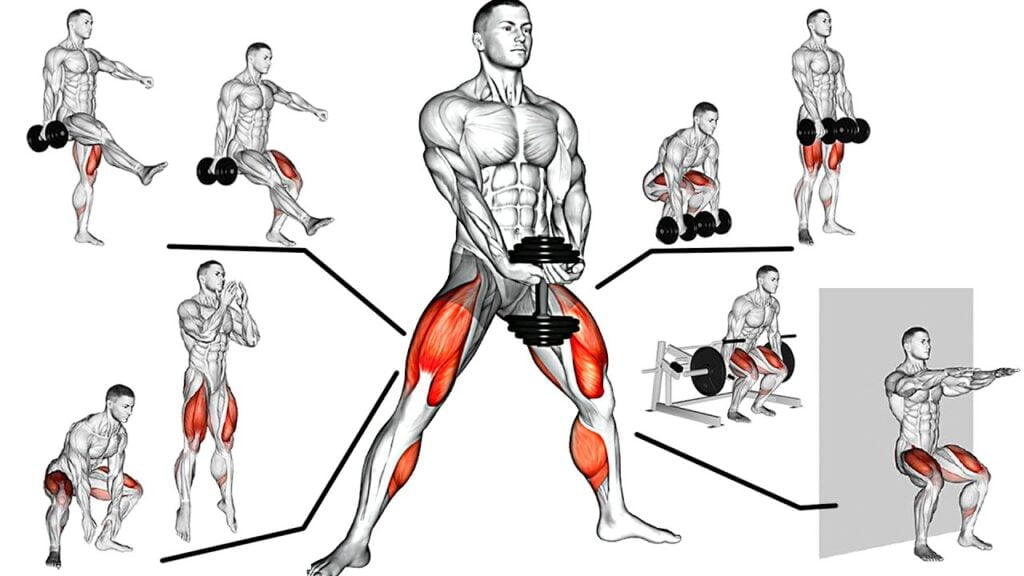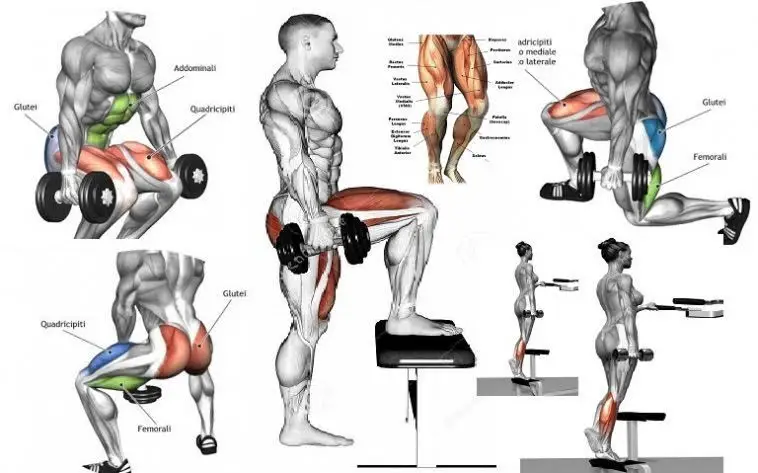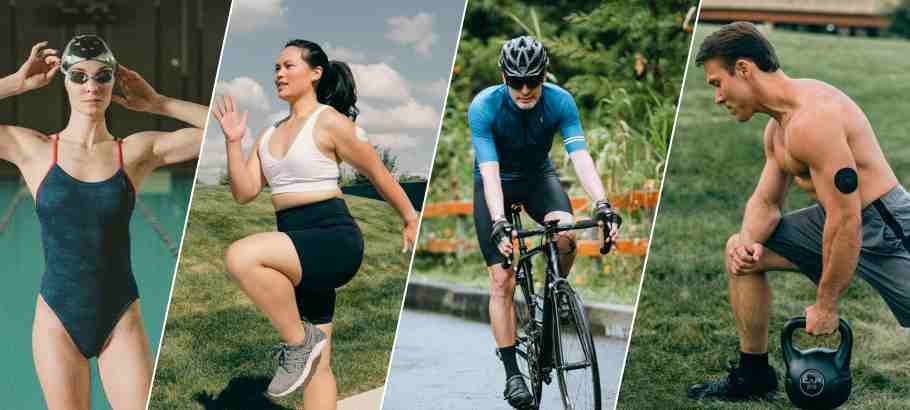Introduction
Leg workouts with weights at home offer numerous benefits for your lower body strength, muscle development, and overall fitness. By incorporating weights into your leg exercises, you increase the resistance, which leads to greater muscle activation and growth. Some key benefits of leg workouts with weights at home include:
- Muscle Strength and Size: Using weights during leg exercises engages your muscles more intensely, leading to increased strength and hypertrophy. This can help you build powerful and well-defined leg muscles such as quadriceps, hamstrings, glutes, and calves.
- Functional Movement: Strong legs are essential for daily activities like walking, climbing stairs, or carrying heavy objects. Weighted leg workouts at home can enhance your leg strength, stability, and balance, improving your overall functional movement capabilities.
- Calorie Burning and Fat Loss: Leg exercises are known for their ability to burn calories and facilitate fat loss. By incorporating weights, you further elevate your heart rate and increase the intensity, resulting in higher metabolic demand during and after the workout.
Importance of Proper Form and Technique
When performing leg workouts with weights at home, maintaining proper form and technique is crucial for maximizing results and preventing injuries. Here’s why it’s important:
SHOP FOR THE BEST ADJUSTABLE DUMBBELL SET ON AMAZON
- Injury Prevention: Proper form ensures that you’re targeting the intended muscles while minimizing stress on your joints and connective tissues. It reduces the risk of strains, sprains, and other injuries associated with incorrect movement patterns.
- Muscle Activation: Correct form allows for optimal muscle activation, ensuring that you’re effectively engaging the targeted leg muscles. This leads to better muscle development and overall workout efficiency.
- Balance and Stability: Proper technique helps improve your balance and stability, enhancing your control over the weights and reducing the risk of falls or accidents during the workout.
Safety Precautions and Warm-Up
Before starting any leg workout with weights at home, it’s crucial to prioritize safety and warm up adequately. Here are some safety precautions and warm-up tips to consider:
- Consultation: If you have any underlying health conditions or concerns, consult with a fitness professional or healthcare provider before attempting any new workout routine, including leg workouts with weights.
- Equipment Check: Ensure that your weights and equipment are in good condition, with proper grip and stability, to avoid accidents or equipment failure during the workout.
- Warm-Up: Begin your leg workout with a dynamic warm-up routine that includes exercises like leg swings, hip circles, and bodyweight squats. This increases blood flow, raises core body temperature, and prepares your muscles for the upcoming workout.
Remember, it’s essential to listen to your body, start with appropriate weights for your fitness level, and gradually increase intensity as you progress.
Equipment and Setup
To perform a leg workout with weights at home, you’ll need some essential equipment to ensure an effective and safe workout. Here’s a list of equipment and tips for setting up your workout space:
SHOP FOR THE BARBELL WEIGHTS ON AMAZON
- Dumbbells or Kettlebells: These versatile weights are great for exercises like squats, lunges, and step-ups. Choose weights that challenge you without compromising proper form.
- Barbell or Weighted Bar: If you have access to a barbell or a weighted bar, you can incorporate exercises like barbell squats and deadlifts into your leg workout routine. Make sure to use appropriate weights based on your strength and experience level.
- Weighted Ankle Weights (optional): Ankle weights can be used to add resistance to exercises like standing leg lifts and donkey kicks, targeting your leg muscles even more.
- Exercise Mat: A comfortable and non-slip exercise mat provides cushioning and stability during floor exercises such as glute bridges and leg curls.
Setting up your workout space
- Choose an open area with enough room for your movements, ensuring you have ample space to perform exercises without any obstacles.
- Ensure that the surface is even and stable to avoid any potential accidents or injuries.
- Keep the weights organized and easily accessible, making it convenient to switch between exercises and adjust the weights as needed.
Remember to warm up properly before starting your leg workout and always prioritize safety by using proper form and technique throughout your exercises.
Warm-Up and Stretching
When it comes to a leg workout with weights at home, warming up before you start your exercises is crucial for preparing your muscles, increasing blood flow, and reducing the risk of injury. Here’s a proper warm-up and stretching routine you can follow:
SHOP FOR THE BEST QUALITY KETTLEBELL ON AMAZON
- Start with 5-10 minutes of light cardio exercises such as jogging in place, jumping jacks, or skipping rope. This will help elevate your heart rate and warm up your entire body.
- Perform dynamic stretching exercises that specifically target the leg muscles:
- Leg swings: Stand near a wall or support and swing one leg forward and backward, gradually increasing the range of motion. Repeat for 10-12 swings on each leg.
- Walking lunges with a twist: Take a step forward into a lunge position, twist your upper body toward the front leg, and then twist to the other side. Alternate sides and perform 8-10 lunges on each leg.
- Leg circles: Lie on your back and lift one leg off the ground. Make circular motions with your leg, gradually increasing the size of the circles. Perform 5-6 circles clockwise and then repeat in a counterclockwise direction. Switch legs and repeat.
3. Move on to specific leg stretches to target the major muscle groups:
- Standing quad stretch: Stand tall, grab your ankle, and pull your heel toward your glutes. Hold for 20-30 seconds on each leg.
- Standing hamstring stretch: Place one foot on an elevated surface (like a step or chair) with your leg straight. Lean forward from your hips, keeping your back straight, until you feel a stretch in the back of your thigh. Hold for 20-30 seconds on each leg.
- Calf stretch: Stand facing a wall, place one foot forward with the knee slightly bent, and lean toward the wall while keeping your back leg straight. You should feel a stretch in your calf muscle. Hold for 20-30 seconds on each leg.
Remember to breathe deeply throughout the warm-up and stretching routine. This will help oxygenate your muscles and prepare them for the upcoming leg workout with weights at home.
Leg Exercises with Weights At Home
Leg exercises with weights are highly effective for building strength and muscle in your lower body. Incorporating weights into your leg workouts can help you challenge your muscles further, leading to increased gains over time. Here are some excellent leg exercises with weights that you can perform at home:
Squats
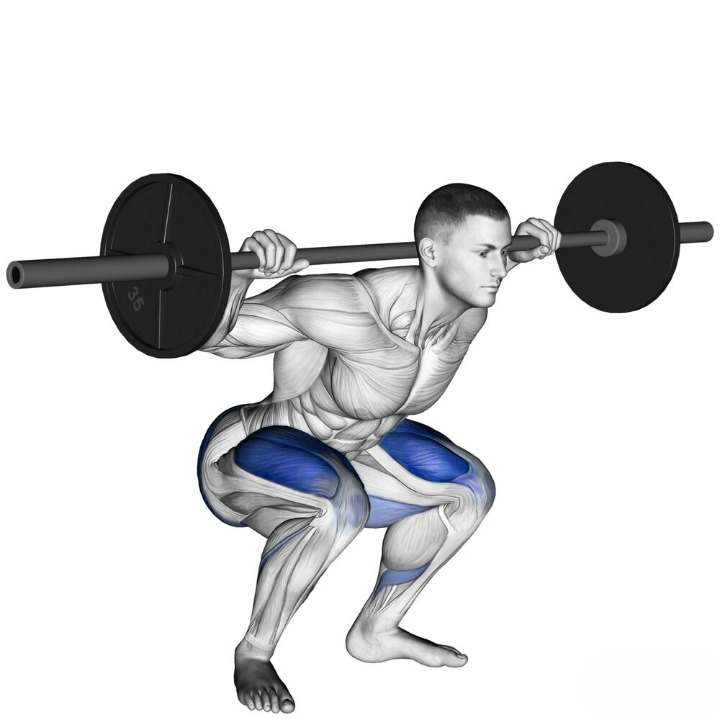
Squats are a fundamental compound exercise that targets the quads, hamstrings, glutes, and calves. You can do squats with dumbbells, kettlebells, or a barbell. Start by standing with your feet shoulder-width apart, hold the weights at your sides, and lower your hips down as if you’re sitting back into a chair. Keep your back straight and chest lifted. Push through your heels to return to the starting position.
Lunges
Lunges are another effective leg exercise that engages multiple muscle groups. With weights in hand, step forward with one leg, lowering your body until both knees form 90-degree angles. Push back up to the starting position and repeat with the other leg. You can do walking lunges or reverse lunges to target different muscle groups.
Step-Ups
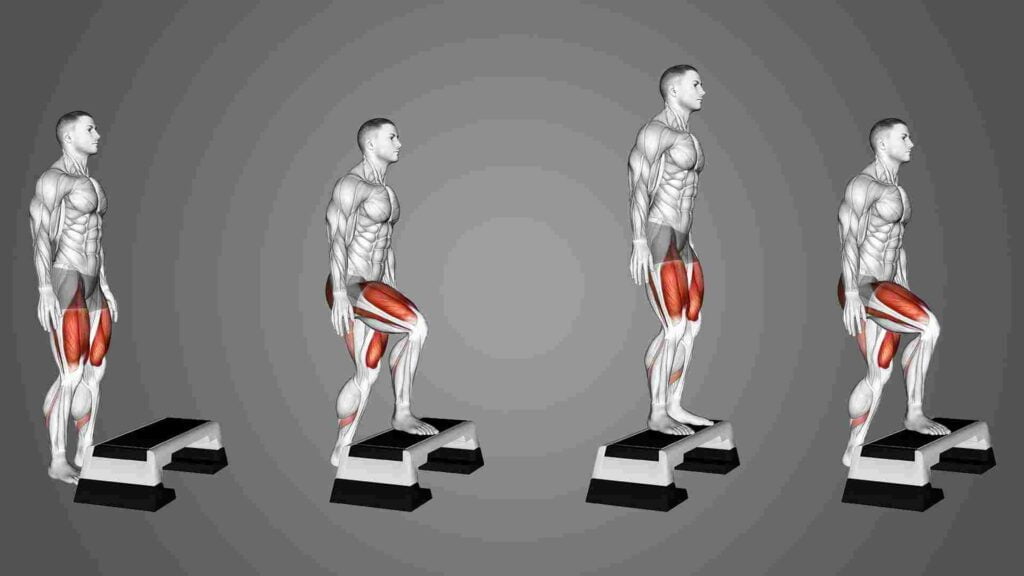
Step-ups primarily target the quadriceps, glutes, and hamstrings. Using a sturdy elevated surface, such as a step or a bench, place one foot on top and step up, driving through the heel of the working leg. Bring your other foot up to join and then step back down. Repeat for the desired number of reps and switch legs.
Deadlifts
Deadlifts primarily target the hamstrings, glutes, and lower back. To perform a deadlift, stand with your feet hip-width apart and hold a barbell or dumbbell in front of your thighs. Hinge at the hips while maintaining a neutral spine, lowering the weights toward the ground. Drive through your heels and engage your glutes to return to the starting position.
Bulgarian Split Squats

This exercise targets the quads, glutes, and hamstrings. Stand a few feet in front of a bench or elevated platform, facing away from it. Rest the top of one foot on the bench behind you. Lower your body by bending the front leg until your thigh is parallel to the ground, then push back up. Repeat for the desired number of reps before switching legs.
Calf Raises
Calf raises target the calf muscles (gastrocnemius and soleus). Stand with your feet hip-width apart and hold a dumbbell in each hand or use a barbell across your upper back. Rise up onto the balls of your feet, lifting your heels as high as possible. Hold for a moment at the top and then lower your heels back down. Repeat for the desired number of reps.
Hamstring Curls
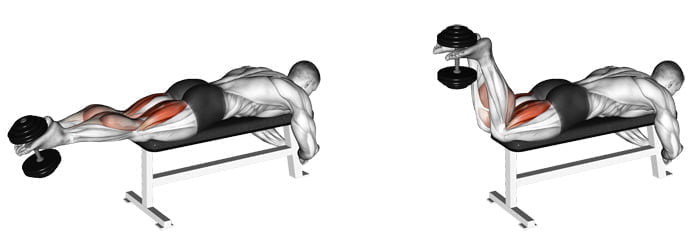
Hamstring curls primarily target the hamstrings. Lie face down on a mat or bench, and secure a dumbbell or ankle weights behind your knees. Keeping your hips grounded, flex your knees to lift your heels towards your glutes. Slowly lower your legs back to the starting position and repeat.
Sumo Squats
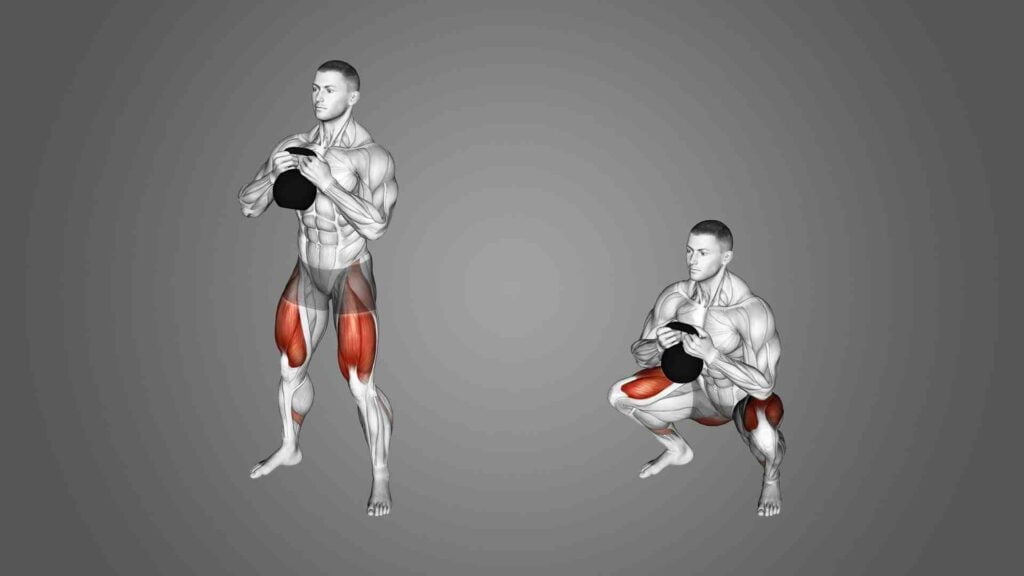
Sumo squats target the inner thighs, quads, and glutes. Stand with your feet wider than shoulder-width apart, toes pointing outwards. Hold a dumbbell or kettlebell with both hands in front of your body. Lower your hips down until your thighs are parallel to the ground, keeping your chest lifted. Push through your heels to return to the starting position.
SHOP FOR THE EXERCISE MAT ON AMAZON
Incorporating a variety of these leg exercises with weights into your home workout routine will help target different muscles in your lower body, promoting balanced strength development. Remember to adjust the weights according to your fitness level, maintain proper form, and listen to your body to prevent injury.
Progressive Overload and Adaptation
Progressive overload and adaptation are essential principles when it comes to leg workouts with weights at home. To continually challenge and improve your leg muscles, it’s important to gradually increase the demands you place on them over time.
Progressive overload involves progressively increasing the intensity, volume, or difficulty of your leg exercises. This can be achieved in several ways:
- Increasing Weight: Gradually add more weight to your exercises, such as using heavier dumbbells, kettlebells, or a barbell for squats or deadlifts. This extra resistance forces your leg muscles to adapt and grow stronger.
- Adding Sets and Reps: Increase the number of sets and repetitions you perform for each exercise. For example, if you start with three sets of 10 reps of squats, you can progress to four sets of 12 reps in the following weeks.
- Varying Exercise Difficulty: Incorporate more challenging variations of leg exercises as you become proficient. For instance, you can progress from bodyweight squats to goblet squats, and eventually to barbell back squats.
- Shortening Rest Periods: Reduce the rest time between sets to keep your muscles under tension for longer periods. This can help enhance the workout’s intensity and stimulate further adaptations in your leg muscles.
By gradually implementing these progressive overload techniques, your leg muscles will be continually challenged, leading to strength gains and muscle growth over time. However, it’s crucial to listen to your body and progress at a pace that is safe and sustainable for you. Remember to maintain proper form and technique throughout your leg workouts to avoid injury.
Tips for Effective and Safe Workouts
When it comes to leg workouts with weights at home, there are several tips you should keep in mind to ensure both effectiveness and safety:
- Start with Proper Form: Before adding weights, master the correct form and technique for each exercise. This helps prevent injuries and ensures you’re targeting the right muscles during your leg workout.
- Choose Appropriate Weights: Select weights that challenge you but still allow you to maintain proper form throughout the exercise. Gradually increase the weight as you get stronger and more comfortable with the movements.
- Warm-Up Thoroughly: Prior to your leg workout, engage in a dynamic warm-up routine that includes leg swings, bodyweight squats, and walking lunges. This helps increase blood flow, improve flexibility, and prepare your muscles for the upcoming workout.
- Focus on Compound Exercises: Compound exercises engage multiple muscle groups simultaneously, making them highly effective for leg workouts. Squats, lunges, and deadlifts are excellent choices for building strength and muscle in your legs.
- Incorporate Variety: To challenge your muscles and avoid plateaus, incorporate different variations of leg exercises. For example, you can try different types of lunges (e.g., walking lunges, reverse lunges) or alternate between barbell squats and goblet squats.
- Listen to Your Body: Pay attention to any discomfort or pain during your leg workout. If something doesn’t feel right, modify the exercise or decrease the weight to prevent injury. It’s important to push yourself, but not at the expense of your safety and well-being.
- Rest and Recovery: Allow adequate rest days between leg workouts to give your muscles time to repair and grow stronger. Overtraining can lead to fatigue, diminished performance, and increased risk of injury.
- Stay Hydrated: Hydration is essential for optimal performance and muscle function. Make sure to drink water before, during, and after your leg workout to stay properly hydrated.
By following these tips, you can ensure that your leg workout with weights at home is both effective in building strength and safe to prevent injuries. Remember to always prioritize proper form, listen to your body, and gradually progress your workouts over time.
Nutrition and Recovery
When it comes to leg workouts with weights at home, proper nutrition plays a crucial role in supporting muscle growth and repair. Here are some key nutritional considerations:
SHOP FOR THE WHEY PROTEIN POWDER ON AMAZON
- Sufficient Protein Intake: Protein is essential for muscle development. Aim to consume an adequate amount of high-quality protein sources such as lean meats, poultry, fish, eggs, dairy products, legumes, and plant-based proteins like tofu or quinoa.
- Complex Carbohydrates: Carbohydrates provide energy for intense workouts. Include whole grains, fruits, vegetables, and legumes in your diet to fuel your leg workouts and aid in recovery.
- Healthy Fats: Incorporate sources of healthy fats like avocados, nuts, seeds, and olive oil. They provide essential fatty acids and support overall health.
- Hydration: Staying hydrated is crucial for optimal performance and recovery. Drink plenty of water throughout the day, especially before and after your leg workouts.
Importance of Rest and Recovery
While leg workouts with weights are essential for building strength and muscle, giving your body enough rest and recovery time is equally important. Here’s why:
- Muscle Repair and Growth: During rest periods, your muscles repair and rebuild, leading to strength and growth. Adequate rest allows your legs to recover from the stress of weight training and prevents overtraining.
- Injury Prevention: Rest days reduce the risk of overuse injuries and allow your connective tissues and joints to recover and regenerate.
- Sleep: Quality sleep is crucial for recovery. Aim for 7-9 hours of uninterrupted sleep each night to support muscle repair, hormone regulation, and overall well-being.
Supplemental Support for Muscle Repair and Growth
While a well-balanced diet should be the foundation of your nutrition plan, certain supplements may aid in muscle repair and growth. It’s important to note that supplements are not a replacement for a healthy diet, but they can complement it. Here are a few commonly used supplements:
- Whey Protein: Whey protein powder is a convenient way to increase your protein intake, especially post-workout when your muscles need it the most.
- Branched-Chain Amino Acids (BCAAs): BCAAs are essential amino acids that can support muscle recovery and reduce muscle soreness. They can be consumed in supplement form or found in protein-rich foods.
- Creatine: Creatine is a popular supplement that may enhance muscle strength and power. It is commonly used by athletes engaged in high-intensity training.
Remember to consult with a healthcare professional or registered dietitian before starting any new supplements to ensure they are suitable for you and your specific needs.
By incorporating proper nutrition, prioritizing rest and recovery, and considering supplemental support wisely, you can optimize your leg workouts with weights at home and promote muscle growth and repair.
FAQs
Q1: What should I eat before a leg workout with weights at home?
Ans: Prior to a leg workout, it’s important to fuel your body with a balanced meal or snack that provides both carbohydrates and protein. Opt for easily digestible foods such as a banana with a tablespoon of nut butter, Greek yogurt with fruit, or a small serving of oatmeal with protein powder. The carbohydrates will provide energy, while the protein supports muscle repair and growth.
Q2: How long should I rest between leg exercises during a weight training session at home?
Ans: The rest periods between leg exercises can vary depending on your fitness level and the intensity of your workout. As a general guideline, aim for 1 to 2 minutes of rest between sets. This allows your muscles to recover partially before the next set, helping maintain performance throughout the workout.
Q3: Can I do leg workouts with weights at home every day?
Ans: It’s generally recommended to allow at least one or two days of rest between intense leg workouts. This rest period allows your muscles to recover and adapt to the stress of the workouts. Overtraining can lead to decreased performance and increased risk of injury. Listen to your body and adjust your workout frequency accordingly.
Q4: Are bodyweight exercises effective for leg workouts, or do I need weights?
Ans: Bodyweight exercises can be effective for leg workouts, especially if you’re a beginner or don’t have access to weights. Exercises like squats, lunges, and step-ups can provide a challenging workout for your leg muscles. However, as you progress, adding weights can further enhance muscle strength and development. Incorporating dumbbells, kettlebells, or resistance bands can add resistance and intensity to your leg workouts.
Q5: Should I stretch after a leg workout with weights at home?
Ans: Yes, stretching after a leg workout is beneficial for promoting flexibility and reducing muscle soreness. Engage in static stretches, targeting the major muscles worked during your leg workouts, such as the quadriceps, hamstrings, and calves. Hold each stretch for 15-30 seconds and repeat for each leg. Stretching can aid in muscle recovery and help prevent tightness and potential injuries.
Q6: How can I track my progress with leg workouts at home?
Ans: Tracking your progress is essential for monitoring improvements and staying motivated. Keep a workout journal or use a fitness app to record the exercises you perform, the weights used, and the number of sets and repetitions completed. You can also track other metrics like the time it takes to complete a workout or the level of difficulty. Regularly reviewing your progress will allow you to adjust your workouts and set new goals accordingly.
Conclusion
In conclusion, incorporating leg workouts with weights at home can be an effective way to build strength, increase muscle mass, and improve overall lower body fitness. By following proper form, using appropriate weights, and incorporating a variety of exercises such as squats, lunges, step-ups, and deadlifts, you can target and challenge your leg muscles effectively.
Additionally, paying attention to proper nutrition, rest, and recovery is crucial for supporting muscle growth and avoiding overtraining. Remember to consult with a fitness professional or healthcare provider to ensure the exercises are suitable for your fitness level and any specific considerations you may have. With consistency and dedication, a well-rounded leg workout routine can help you achieve your fitness goals and enhance your overall well-being.

Good day, and welcome to Fitthour. My name is Shubham Vijay, and I am a certified personal trainer and nutrition coach with 6 years of experience in the fitness industry. At Fitthour, we specialize in types of training, such as strength training, cardio, or HIIT, and our mission is to help clients achieve their fitness goals and improve their overall health.

